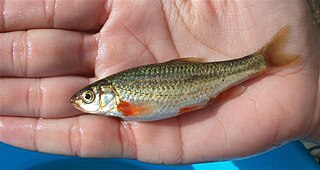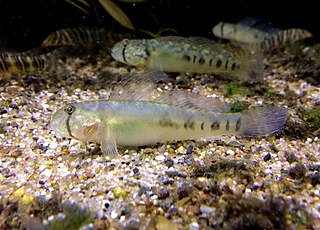The Marmara barbel is a species of cyprinid fish endemic to Turkey where it is only known from fast flowing waters with substrates of stones or pebbles. This species can reach a length of 35 centimetres (14 in) SL.
Tabebuia anafensis is a species of plant in the family Bignoniaceae. It is endemic to Cuba. It is threatened by habitat loss.
Tabebuia arimaoensis is a species of plant in the family Bignoniaceae. It is endemic to Cuba.
Tabebuia bibracteolata is a species of plant in the family Bignoniaceae. It is endemic to Cuba.
Tabebuia dubia is a species of plant in the family Bignoniaceae. It is endemic to Cuba. It is threatened by habitat loss.
Tabebuia elongata is a species of plant in the family Bignoniaceae. It is endemic to Cuba.
Tabebuia furfuracea is a species of plant in the family Bignoniaceae. It is endemic to Cuba. It is threatened by habitat loss.

Tabebuia hypoleuca is a species of plant in the family Bignoniaceae. It is endemic to Cuba.
Tabebuia jackiana is a species of plant in the family Bignoniaceae. It is endemic to Cuba.
Tabebuia lapacho is a species of plant in the family Bignoniaceae. It is found in Argentina and Bolivia. It is threatened by habitat loss.
Tabebuia platyantha is a species of plant in the Bignoniaceae family. It is endemic to Jamaica.
Tabebuia polymorpha is a species of plant in the family Bignoniaceae. It is endemic to Cuba. It is threatened by habitat loss.
Tabebuia shaferi is a species of plant in the family Bignoniaceae. It is endemic to Cuba. It is threatened by habitat loss.
Tabebuia striata is a species of plant in the family Bignoniaceae. It is found in Colombia and Panama. It is threatened by habitat loss.

Bothrops oligolepis is a venomous pitviper species found in Peru and Bolivia. The specific name is derived from the Greek words oligo and lepis, meaning "few scales"; probably an allusion to the lower numbers of dorsal and ventral scales that it has compared to B. bilineatus. No subspecies are currently recognized.

Achondrostoma oligolepis is a species of cyprinid fish. It is endemic to central and northern Portugal and known from between Limia and Tornada drainages, south of Douro. It occurs in the lower stretches of rivers and streams. It can grow to 25 cm (9.8 in) total length, although it typically measures about 15 cm (5.9 in) TL.

Pristilepis oligolepis, the spinyface soldier, is a species of soldierfish found in association with reefs in the Indian and Pacific Oceans. It can be found at depths of from 14 to 220 metres. This species grows to a length of 30 centimetres (12 in) TL. This species is the only known member of its genus.
Ekmanianthe is a genus of flowering plants in the family Bignoniaceae. It is most closely related to Tabebuia and has sometimes been included within it. It consists of two species of trees, neither of which is especially common in any part of its range:

Oligolepis acutipennis, the sharptail goby, is a species of goby native to marine, freshwater and brackish waters along the coasts of Indo-West Pacific region. This species can reach a length of 12 centimetres (4.7 in) TL.

Tabebuia heterophylla is a species of tree native to the Caribbean, and is also cultivated. It is also known as Roble blanco, pink manjack, pink trumpet tree, white cedar, and whitewood.






